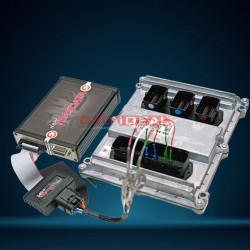
AdBlue Malfunction Causes, Solutions, and Frequently Asked Questions
AdBlue is a fluid composed of purified water and urea, used to reduce emission levels in diesel engine vehicles. This system is primarily used in heavy-duty vehicles and is designed to decrease the release of harmful gases into the environment. However, over time, the AdBlue system may develop malfunctions, leading to serious problems for drivers.
Why Does an AdBlue Malfunction Occur?
AdBlue malfunctions typically arise due to poor fuel quality, low-quality AdBlue fluid, sensor failures within the system, or mechanical issues. The repair of an AdBlue system malfunction focuses on diagnosing and resolving these types of problems. If the AdBlue tank runs out of fluid, the vehicle will activate a warning light and may experience reduced performance. This could cause the vehicle to drop from high emission standards like Euro 5 or Euro 6 to as low as Euro 1.
What is the AdBlue Warning Light and Why Does it Illuminate?
The AdBlue warning light is an indicator that there is an issue within the AdBlue system. It typically illuminates when the fluid level is low, there is a blockage in the system, or there are sensor malfunctions. When this light comes on, the vehicle may experience a drop in performance and an increase in fuel consumption. Additionally, the vehicle may break down or fail emissions tests.
What Happens if AdBlue Runs Out?
If the AdBlue fluid runs out, the vehicle will no longer be able to meet emission standards. In this scenario, the warning light will illuminate, and in some vehicles, the engine may stop running altogether when the fluid is completely depleted. This can cause significant issues for drivers, especially during long journeys. The question "Will I be stranded if AdBlue runs out?" stems from these concerns, highlighting the importance of regularly checking the AdBlue level.
AdBlue System Repair and Solutions
There are several methods to resolve malfunctions in the AdBlue system. First, it’s crucial to identify the source of the problem using a diagnostic device. Following this, it may be necessary to replace faulty parts or components. In some cases, malfunctions may become chronic and recur frequently, raising the question, "Is AdBlue removal beneficial?" AdBlue removal disables the vehicle’s emission control system and prevents the warning light from activating.
Among the most common AdBlue malfunction solutions is repairing or replacing the system. However, these methods can be costly and may not provide a long-term solution. Alternatively, the AdBlue reset process can be performed. Resetting involves restarting the system and turning off the warning light, which can be done easily with a diagnostic device.
AdBlue Removal and Emulator Usage
For drivers experiencing chronic AdBlue malfunctions, another option is the use of an emulator. Emulators used in conjunction with AdBlue removal ensure that the vehicle maintains a certain fluid level and sends a signal to the engine control unit indicating the system is functioning correctly. This method can offer a permanent solution and prevent the warning light from illuminating. However, it should be noted that such interventions may have legal implications and could harm the environment.
How to Perform an AdBlue Reset?
After resolving an AdBlue malfunction, an AdBlue reset can be performed to turn off the warning light and reset the vehicle’s system. This process is usually carried out using a diagnostic device and is quite simple. The reset process clears error codes on the vehicle’s engine control unit and restores normal operation.
The AdBlue system is an important environmental protection feature for diesel vehicles, but malfunctions within the system can be challenging for drivers. Understanding the causes of an AdBlue malfunction and the available solutions can help vehicle owners address such issues effectively. Regularly checking the AdBlue fluid level and seeking professional help when a malfunction occurs will prevent major problems in the long run.


-75x75w.jpg)


-75x75w.jpg)










-75x75.jpg)





-75x75w.png)



-250x250.jpg)

-250x250.jpg)
Leave a Comment